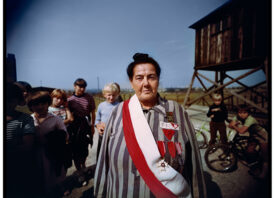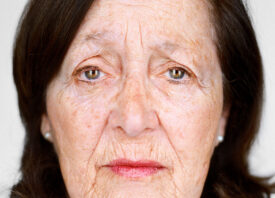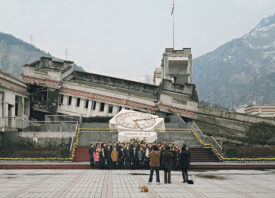Search this site
Honoring Auschwitz Survivors Through Food Photography

Honey Cake & Latkes: Recipes from the Old World by the Auschwitz-Birkenau Survivors is a book from Melcher Media and the Auschwitz-Birkenau Memorial Foundation, beautifully illustrated with food photography by Ellen Silverman.

“My mother used to say, ‘I’d rather spend the money on the butcher than the doctor.’ After the war, things were tight. I had pictures of me where the biggest object on my face was my ears. I looked like Dumbo with the ears. I was so skinny, very emaciated. I had these gigantic ears and a small face, and I didn’t like food. If I saw a lot of food, I would throw up, I guess from the hunger. . . . When my mother found me after the war, she tried certain things. I would only eat certain things. I liked chocolate. Who doesn’t?
“She would take a slice of black bread, put a lot of butter on it, then take hard chocolate and shave it down and pat it into the butter. She was trying to fatten me up. So, I would bite into this thing. How bad can black bread be with butter and chocolate?” – Eugene Ginter
“Just before his sixth birthday, Eugene Ginter was liberated from Auschwitz,” the photographer Ellen Silverman tells me. He was moved to a Jewish orphanage, and his mother found him after hearing about a boy with red hair. By the time they reunited, he was emaciated and had trouble eating, so his mother created a special recipe for him.
“Her goal was to get him to eat,” Silverman explains. “She knew Eugene liked chocolate, so her solution was to create a chocolate sandwich.” Silverman’s portrait of Eugene Ginter making his mother’s chocolate sandwich starts off the cookbook Honey Cake & Latkes: Recipes from the Old World by the Auschwitz-Birkenau Survivors.
It’s a memory that’s stayed with Eugene Ginter throughout his life, as he moved with his family from Czechoslovakia to Austria and finally to the United States, where he became a mechanical engineer. Honey Cake & Latkes is an ode to the many dishes that survived the unthinkable, the people who made them, and the memories and dreams they carried.
Rachel Roth, who was imprisoned in Majdanek, used to share stories about Friday night dinners, as the other women listened, remembered, and imagined. Benjamin Lesser remembers making compote with the fruits from his grandfather’s orchard in Munkatch, Hungary, as a child; now, he lives in Los Vegas, and he makes his compote with fresh pears from his garden. Anneliese Nossbaum left her waffle recipe tied to her will with ribbon so that her children would always have it. And Marion Wiesel shares Elie Weisel’s latke recipe.
Silverman, who is passionate about food photography, spent several days with five of the survivors in the photo studio, watching them make their recipes from scratch. “One of the most astonishing revelations of the survivors’ stories is that they often talked about food in the camps, which seems counterintuitive while being systematically starved,” she reflects.
“Sharing recipes and recounting meals was a way to keep people connected to their families and loved ones. After the war, preparing favorite dishes helped to keep alive memories of those who perished and served as a bridge that connected and bonded the new generation to the old.” We asked her to tell us more about what it meant to help to bring this book to life.

“After the Shoah, I had no mother who could teach me how to cook and bake, so I learned as much as I could from my husband Andor’s mother, Ilonka Schwarcz. I learned this recipe from my mother-in-law when I was seventeen. I remember how she would light the Shabbat candles behind closed curtains in Budapest and then serve this soul-warming soup on Passover or Shabbat. Today my daughters Judith and Anita also cook this matzo ball soup for their families according to Ilonka’s recipe.”
Can you tell us about the in-studio food photography sessions you did with the survivors?
“At one of our pre-production meetings, I asked Maria Zalewska, the Executive Director of the Auschwitz-Birkenau Memorial Foundation and the project’s editor, if she thought it would be possible to have some of the survivors come to the studio during the shoot so we could photograph them preparing their recipes.
“This was a difficult ask as it was during the height of the pandemic. It turned out, though, that five childhood survivors of Auschwitz-Birkenau, all between the ages of 82 and 93, were eager to come to the studio to work with us during two of our shoot days.
“The most difficult part of photographing them was having to concentrate on shooting while listening to them share their stories. There were several moments where I caught myself looking through my lens with tear-filled eyes. Poignant stories were interspersed with many moments of laughter. It was an honor to have them as our guests and hear their stories. Some even brought family photos to share with us.
“They were fascinated by the process of taking the photos. ‘All these people in the kitchen just to take pictures of us making matzoh balls,’ wondered one survivor. At the end of the shoot, I showed them the photos; they loved seeing the results and, of course, all had opinions about which photos were best. One noticed red lipstick on her teeth and asked for a reshoot. No need, I told her, promising I could easily remove the lipstick in retouching.
“Despite feeling weak from chemotherapy, another survivor, a Romanian Jew who was sent to Auschwitz at age fifteen along with several family members (miraculously, eight of his eleven siblings survived), still cooked two dishes during his shoot. With a twinkle in his bright blue eyes, he joked with me as I photographed him making his mother’s stuffed cabbage and shlishkes recipes.
“Sadly, he passed away before the publication of the book. His wife told me that she was able to show him the PDF of the book before he died. He was delighted to see his photos and happy to know that his story and family recipes will continue to be shared.”

“This vinegary cucumber salad has always been our favorite special Shabbat and holidays side dish. I also like to make it when I have special guests over. The tangy taste of the salad goes very well with meat, especially roast beef, chicken cutlets, or veal. It tastes best when served chilled. Children love it too! “The recipe goes back to my grandmother, who passed it on to my mother, who then passed it on to me. I, in return, have shared it with my daughters and granddaughters. Five generations have loved and made it! The recipe has not changed at all over the years. I always say that if it’s not broken, don’t fix it.”

You went to a gathering in October 2021 with some of the survivors who contributed to the book. What was it like to be there?
“The publication of the book was celebrated at a gathering that was simultaneously celebratory and emotional in the elegant wood-paneled dining room of Café Sabarsky at the Neue Galerie in Manhattan. Waiters passed trays of hors d’oeuvres filled with offerings from the book: potato latkes, eggplant salad, rugelach, and other favorite recipes, as survivors, family members, friends, and press began to fill the room.
“I felt humbled to be in this room and grateful to have had the opportunity to tell a part of these survivors’ stories by memorializing some of their memories of family through their treasured recipes and by photographing some of them making the recipes they had shared.
Although it may seem at odds with the experience of the holocaust to write a cookbook, as Ronald Lauder said, ‘this book is a story of hope and triumph of the human spirit.’
“Maria Zalewska added, ‘More than a cookbook what you are holding in your hands is a collection of heirloom recipes that convey survivors’ stories through the mnemonic lens of cooking and food.’
“For so many of us, just a bite or the aroma that a specific dish releases conjures a flood of memories of family, friends, home, and celebrations. Standing in this room amongst all of these people here to applaud the publication of Honey Cakes and Latkes reinforced the fact that this book is much more than a cookbook. It is a collection of the individual memories of survivors, brought to life to be shared with future generations.
“There are two things that I will always carry with me from this project: the experience of meeting and photographing the five survivors who came to the studio was so powerful and touching, and then being together again to celebrate the launch of the book.
“For me, this book is the most important book that I have photographed. It goes well beyond being simply a book of recipes. Rather, it is a book that honors and preserves the lives of those who were lost in the holocaust and is ultimately a celebration of life and triumph for those who survived under a system determined to destroy them.”

“Elie Wiesel’s family latkes recipe has been shared lovingly with a dear family friend, Ronald S. Lauder. As Marion Wiesel says, it’s simple and easy.”

Eva’s son John recalls: “This was my mom’s spin on an old family cherry soup recipe. She experimented with the original recipe and came up with the strawberry soup recipe on her own. This recipe was a summer favorite growing up. My mom used to make it for us on long, warm days. I remember being called inside by her after playing on a hot summer’s evening and having this tasty and refreshing soup as a starter for dinner.
“It’s always best served cold. The combination of wine, sour cream, and strawberries tasted like my childhood. The red wine somehow brings out the flavors of the dish. You can’t taste the red wine on its own, but it’s vital for enhancing the strawberry flavor. It’s a refreshing and perfect combination!”
Can you tell us a bit about the art direction for the food photography? Why did you choose the photograph the dishes the way you did?
“I approached each shot as if I were taking a portrait with the focus being solely on revealing the character of the food. I was guided by Maria’s vision for the book that the food photographs look modern without a trace of the old world, they should be ‘clean,’ which meant keeping things minimal—a surface, plate, and perhaps a utensil so that the food would be the focus.
“She directed us to keep the backgrounds cool and neutral in color and to avoid any props that would suggest nostalgia. This presented a unique challenge as these Eastern European recipes for the most part are lacking color. What at first seemed a challenge, came together as a stunning collection of photographs, a perfect compliment to the design of the book.”

Is there anything you’d like to add?
“There is an excellent quote from Tova Friedman,* one of the survivors who was at our shoot, that I wanted to mention: ‘Food is home and if you talk about it the smell comes back to you and home comes back.’ I think this is the essence of the survivors’ relationship between food, home, and memory. It really encapsulates everything I was trying to say.
There is a word, commensal, which has a scientific meaning but also a social one. The derivation is Latin for ‘coming together at the table.’ When we come together at the table to share food, all of life flows from this spot—it truly is where we share everything, from the mundane parts of our days to the big things that are happening in our lives.
“Stories get passed down through recipes—whether you are cooking with an older family member who is teaching you a family recipe that they ate as a child or whether you have been forced from your home and your country and have had to leave with only what you can carry. You always carry your food traditions and your recipes, which you can recreate wherever you go. They will always bring you back home, hopefully to the sweetness left behind and not the trauma.”
*“By the way, since the book was published, Tova Friedman’s grandson has helped to turn her into a TikTok sensation. She has over 8.9 million followers, and she is also a working therapist! “

“My mother would go to the fish store and pick the fish that looked healthy, insisting on Michigan whitefish. In Poland, before the war, my grand-mother would buy live fish. She would put a wad of cotton soaked with vodka in the fish’s mouth. Then she would remove the cotton and put the fish in the bathtub until she was ready to cook it.
“I shared this recipe with my wife, Rachelle. She only makes it at Passover because it is so much work to prepare.
“After the war, we ate to live, not lived to eat. Because what happened was, I lost my parents twice. Once in the war when they took me away from my mother. Then they took my father away from me. Then I was in an orphanage for months. I didn’t have a mother for almost a year until she found me after the war. The fact that we were together was more important to me than what was put on the table.”

“I created this recipe from memories of my mother making it with and for the family. I started making this butter cake with my mom when I was very young, maybe about ten years old. She was always making Boterkoeke for the family. She was the youngest sister of eight and became a baker for all of the family. Her sisters’ friends would always take slices home for their husbands. I was about ten years old when I understood what she was doing and memorized the recipe.
“When I was taken to Auschwitz and got accustomed to it, I began to think, How can I remember my mom and our family life? I told myself, Look, the only way you’re going to do it is to make Boterkoeke. So I remembered the recipe and continued to make it all these years after Auschwitz. It’s a straightforward recipe.”

“When I came to Canada, I came first as an orphan because my mother couldn’t come. She arrived a year later with my aunt and my grand-mother. The three of them started cooking. They couldn’t afford to go to a restaurant at that time or anything. We lived in an attic, but we could use the kitchen, and they started baking.
“This sponge cake recipe is theirs. It was passed down to me by my mother. I always bake it in my mother’s old sponge cake pans. The pans are now 70-plus-years-old aluminum tube pans. I believe the pans give the cake its exceptional taste. What makes this cake delicious is the fluffy texture and not-too-sweet flavor.
“One of my favorite memories connected to this recipe is quite charming. I was invited to a friend’s party and decided to bake this sponge cake in advance. When I arrived at the party, I realized it was a surprise twenty- fifth wedding anniversary party for my husband, Roman, and me organized by our three children. I looked at the sweet table and saw my cake on the table. I cherish that memory.”

“I was eleven years old when the war broke out. I was very eager to help my mom: washing the dishes, peeling potatoes, or helping with whatever she needed me to do in the kitchen—and she was grateful for that. I noticed how diligently she worked to put the ingredients together for the blueberry stonekes. The end product was so delicious—better than any bakery could possibly bake. The whole family was wild about them. When you bit into the stonekes, they were full of blueberries and sugar—so juicy—the taste has stayed with me forever. The stonekes remained so much in my memory that I taught my wife how to make them when I got married.”

“On July 11, 1944, Michael and his parents, brother, and grandparents were put on cattle cars and deported to Auschwitz. Upon arrival in the camp, men and women were separated. Michael, being four years old, was sent to the children’s barrack. Soon after, Michael’s mother learned that both Israel and Samuel were murdered in the gas chamber.
“The children in Michael’s barracks were older and took every opportunity to steal his bread. Sophie would sneak into the barracks to give him her bread rations. Even the beatings she received for her actions would not deter her. To further protect Michael, Sophie snuck him into the women’s barracks, where his grandmother Dora would hide him under straw while the women went to work.
“When Sophie was sent to Austria to work in a munitions factory, Michael remained in the women’s barracks with Dora. As the Soviet army advanced, the prisoners were set to embark on a death march. Neither Michael nor Dora would have survived the harsh conditions of the march. They hid in the infirmary, which saved their lives. After spending six months in the camp, Michael was liberated.
“When Sophie returned to Zarki, she searched for valuables they had buried in the backyard of their old house. Everything was stolen except for a kiddush cup that became a family heirloom.
“In 1956, Michael and Sophie emigrated to the United States. Michael felt invisible in his new surroundings, where he didn’t speak the language. He had no money, no father, and a number tattooed on his arm. Sophie taught Michael her optimistic mantra: ‘This too shall pass.’ That stayed with Michael for the rest of his life.
“War experiences haunted Michael. He remembered the putrid smell of burning flesh, the sound of screams and marching boots, the beatings. As a result, he contemplated removing his tattoo and changing his name. After seven decades of silence, Michael recounted his story to his oldest grandson’s classmates.
Michael lives in New Jersey with his wife, Judy. They have four kids and twelve grandkids.
“He still uses his mother’s kiddush cup for every Shabbat, holiday, or special event.”
**Book credits: Chris Steighner, editor at MELCHER Media, and Auschwitz-Birkenau Memorial Foundation executive director Maria Zalewska. Food Stylist: Christine Albano. Prop Stylist: Suzie Myers.
Further reading:
• Martin Schoeller’s Portraits of Holocaust Survivors Are As Urgent As Ever
• A Poignant Portrait of Survivors of the Holocaust
• One Photographer’s Journey to 12 Nazi Concentration Camps



